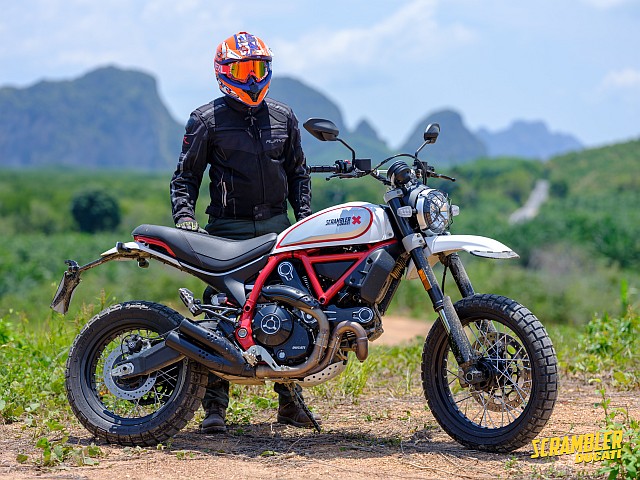
We were invited to get a taste of the new 2019 Ducati Scrambler 800 line-up in stunning Khao Lak, Thailand.
Story: Zal Cursetji
Photography: Ducati
At the turn of the 20th century, adventurous motorcyclists with a penchant for speed met at their local cafeterias where they would race each other from point to point. This often dangerous madness — and at times illegal, too, one may add — gave rise to the “café racer” style that we all have come to love. But there were others. Others who had the same intention, racing from point A to B, yet had no intention to follow the beaten path. This meant getting off any roads and riding through whatever may lie between the start and finish. Fields, hills, slushy meadows, rivers, and more — all requiring their motorcycles to perform in a fairly different manner. This even madder madness saw the evolution of one of the most versatile styles of motorcycles: the scrambler.
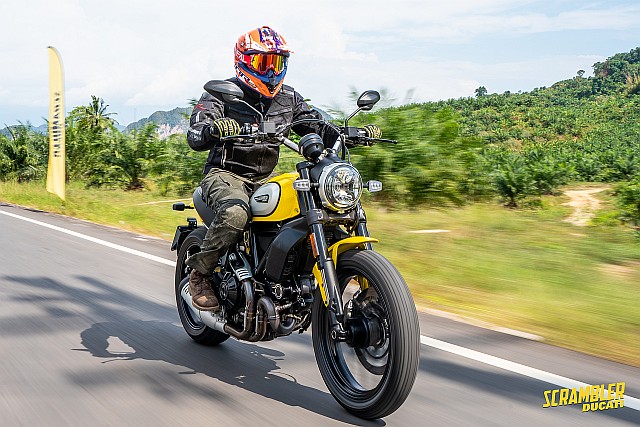
Today, scramblers have become a lifestyle rather than a full-on weekend racer, as today we have specialized vehicles for said activity. The scramblers of the modern age can still put a smile on one’s face and will still do all that their predecessors did. However, these motorcycles are more at home in urban surroundings with a hint of adventure whence it calls out. For most of us, that is all we really need and the reason why scramblers have continued to make such a climb back into our garages. I have no complaints about this and sure am a fan of these motorcycles that are easy to ride, forgiving on bad roads, and can take a bit of a beating. In an urban environment, though, a little style would be nice and that’s where a certain Bolognese motorcycle giant comes into its own.
Ducati relaunched their scrambler name in 2014, with the Scrambler 800. This was followed by a number of different models under the Scrambler brand-name, sporting different engine capacities. The bikes were much loved and sold well the world over; however, they did have a few niggles and oddities; would not be Italian if they didn’t. But, albeit, the Scrambler Ducati brand has been quite a success story for the Italian motorcycle manufacturer.
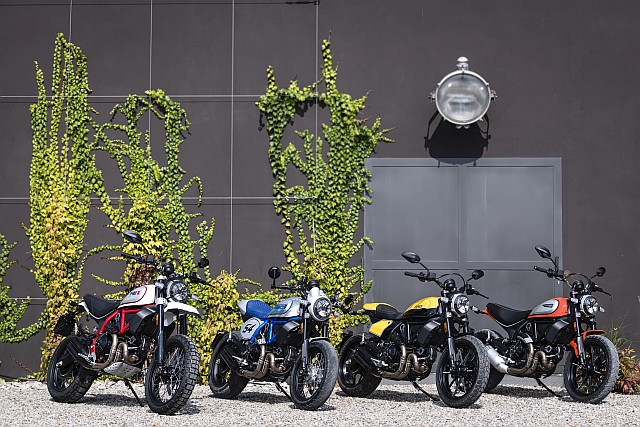
For 2019, Ducati are launching their new range of the Scrambler 800 with four different variants on offer: Icon, Cafe Racer, Full Throttle, and Desert Sled. We were lucky enough to be able to ride two of these variants in Khao Lak, Thailand: the Icon and the off-road-centric Desert Sled.
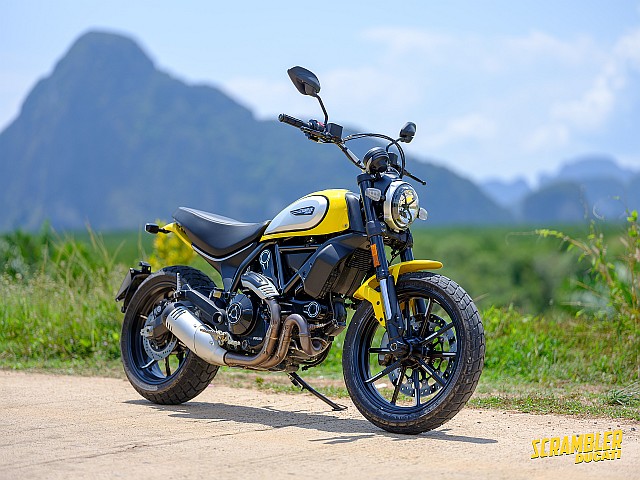
The Scrambler Icon is the most successful variant of the range. The motorcycle sits low and has raised handlebars, giving it a very comfortable riding position. The new bikes have been given a few fresh styling cues, while still keeping to the original design. The tank now has a beefier removable side-panel very similar to the big Ducati Scrambler 1100. The LED headlamps now have daytime running LED units included and also feature black crossbars to mimic the taping seen in off-road motorcycles. The engine has been painted black and seems to fit in pretty well with the overall look; subjective, though. In addition, the bike also gets new LED indicators which are self-cancelling ones and work quite well. Finally, the seat is slightly plusher, which adds to a comfier ride.
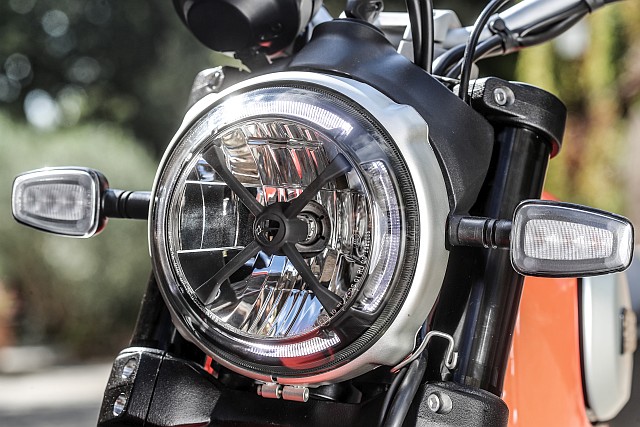
The engine remains unchanged here, which is a simple 803-cc air-cooled L-twin Desmodromic distribution unit that makes 73 PS and 67 Nm of torque. Power is delivered to the wheels via a six-speed transmission that has a good mechanical feel. There were some riders that suffered from a rare false shift; something I did not feel. However, I did, on an occasion or two, struggle with finding neutral when at standstill. In addition, the new models have been given a new 50-mm throttle body which seems to have weeded out the slightly choppy throttle response from the early scramblers while providing a powerful yet linear surge when on the gas. However, Ducati claims that they worked on this when switching to the Euro 4 emission norms. Either way, I found myself confidently accelerating out of corners due to this smooth throttle delivery and also found myself changing gears less often due to the torque kicking in early at 3,000 rpm. Furthermore, Ducati have done away with the old clutch cable and thrown in a hydraulic unit. This has resulted in the clutch feeling lighter and much smoother; sure will be handy when navigating through our snarling traffic jams.
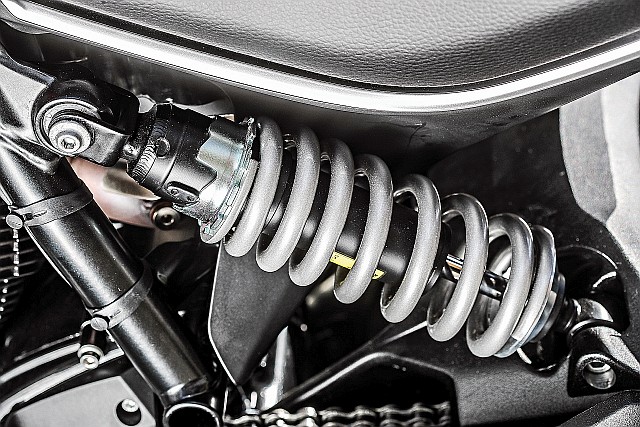
During my time on the Icon, the heavens opened up and about 100 odd kilometres were spent on wet winding roads, where I am pleased to say that the Pirelli MT 60 RS tyres were superb. We were quite often travelling on these wet roads at triple-digit speeds and found good grip and control even when leaned over. No complaints at all with the Pirelli MT 60 RS tyres. The tyres are draped around 10-spoke 18-inch alloys up front and 10-spoke 17-inch alloys at the rear.
There are changes to the suspension, too. Though not really noticeable to the untrained eye, you sure can feel it. Ducati seems to have worked on the damping in the upside-down 41-mm Kayaba front forks which seem to have done the trick. I hit an unseen deep pothole at triple-digit speed and was met with a dull thud rather than a fractured spine. Please do not test this theory in the same manner. The story is similar with the Kayaba rear suspension, as it feels softer yet better damped and is pre-load adjustable. There is 150 mm of travel for both, front and rear, and bottoming that out is possible if you are pushing it through a bumpy patch. However, most of us would not be braving such behaviour and would be very pleased with the planted and confidence-inspiring feel it offers.
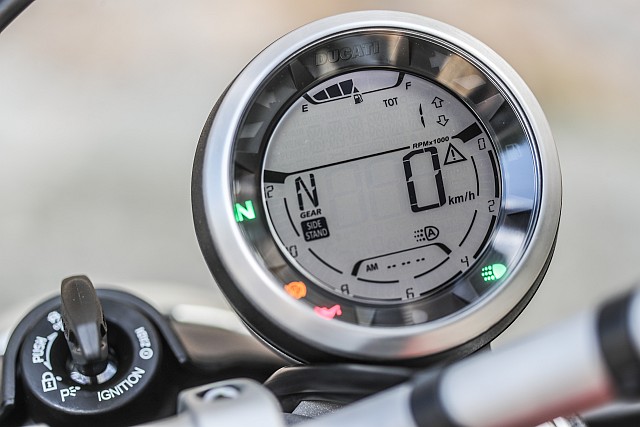
For the 2019 Scrambler models, Ducati have added 330-mm Brembo M4.32B monobloc radial four-piston caliper with Bosch Cornering ABS up front and a 245-mm single-piston floating caliper with Bosch Cornering ABS unit at the rear as standard right across their new Scrambler range. A very good safety upgrade, especially in our country where every blind corner is a throw of the dice in regards to traffic, livestock, and vagabonds. Furthermore, since it is the 21st century, Ducati have also thrown in a fuel-gauge and gear indicator. This was not exactly a huge issue, but it was something that many Ducatisti Scrambler owners asked for and Bologna complied.
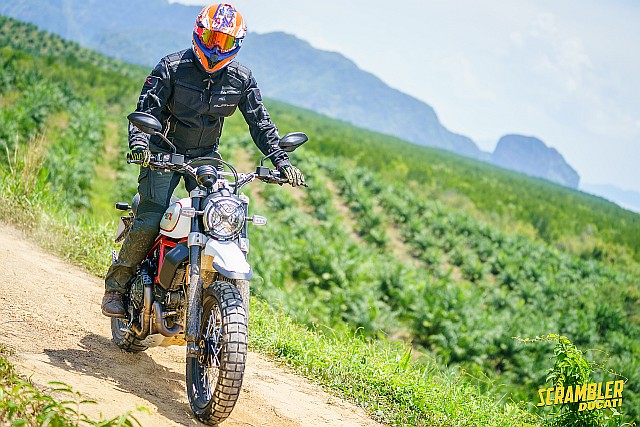
The second bike in the Scrambler range we rode was the more off-road capable Desert Sled, and “oh, heavens above” that very nice lady will have you singing all day. Mechanically, it is identical, powered by the same engine, and shares the same tubular steel Trellis frame from across the entire range. The big differences are mainly with the styling and its off-roading prowess components. However, apart from receiving the changes that have already been mentioned, the motorcycle is the same as the outgoing model. Well, almost. Design-wise you see new tank panels, comfort has been improved with the new plusher seat, and feature-wise you also get all the upgrades which are now standard offerings in the range.
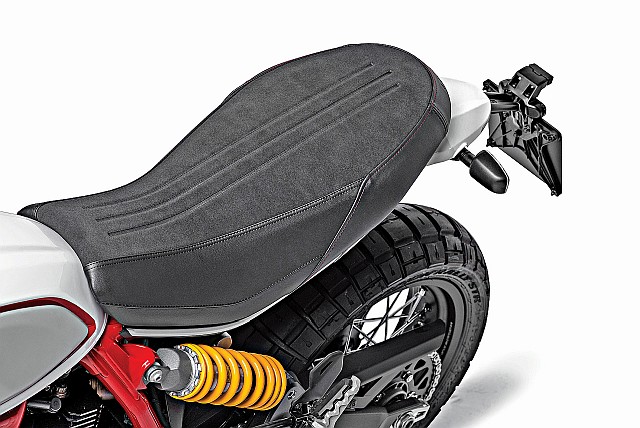
The Desert Sled, though, is the one I would have if the choice arose. It feels right at home on the twisties as it does when blasting down swooping dirt roads. This motorcycle can indeed handle some light trail riding, too, but it really is not meant for that and would require a little more skill. More importantly, though, is how easy it is to ride on the rough stuff and would not be a handful for even novice off-road riders. At 5’ 9” I could just about get both my feet on the ground as the low seat height option is 840 mm (42 mm more than the Icon). The bike sports Kayaba 46-mm fully adjustable upside-down forks and Kayaba pre-load and rebound adjustable rear shocks, both having 200 mm of travel. Once again, we see some very well-performing tyres here, both on and off-road, with the Pirelli Scorpion Rally STR, draped around 19-inch spoked aluminium wheels in front and 17-inch spoked aluminium wheels at the rear.
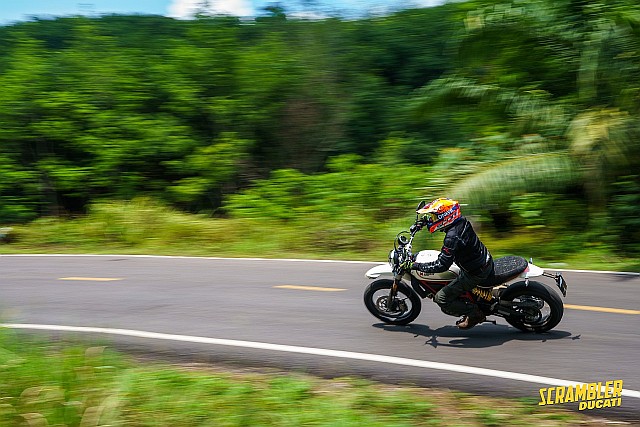
Ducati, as we mentioned earlier, have said that the range is an evolution of what was already on offer and, again, that is exactly what the new models are. I would go so far as to say that the Desert Sled, which is capable of touring, off-roading, commuting, and throwing around on winding tarmac is in all possibility one of the best motorcycles one can buy. However, there is a problem and this is a big problem, especially in a country like ours. Heating. These bikes get hot, very hot. Yes, they are air-cooled units and, yes, we rode them in a very hot and humid April in Khao Lak. But we were moving at a decent pace which should keep that engine bearable. I am afraid that owners will continue to complain about this issue as they have in the past. I do hope Ducati work out a way to maybe find better heat dissipation as it would really make these great motorcycles hard to fault.
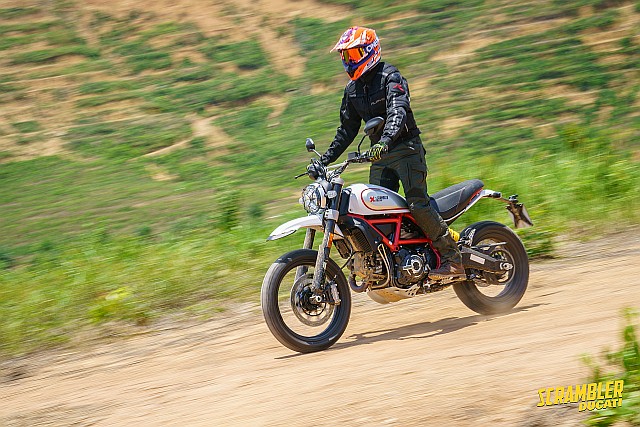
All in all, Ducati’s Scrambler range is a sure winner. These bikes look truly amazing and ride really well. They fit right in when in an urban environment and will keep you very happy when a little fun is the need of the hour. Yes, there are a niggle or two, but which motorcycle doesn’t? Would I buy a Ducati Scrambler? I would, but, Ducati have just announced the pricing for the new range. The 2019 Ducati Scrambler Icon is priced at Rs 7.89 lakh ex-showroom and the Desert Sled at Rs 9.93 lakh ex-showroom. The Cafe Racer and Full Throttle fall in-between the aforementioned two. This, unfortunately, is still on the steeper side, especially when considering new releases from other manufacturers. A little more aggression on the pricing and the bikes would be gold.
For the pricing of the full Ducati Scrambler 800 range click on the link: 2019 Ducati Scrambler Range Launched


Leave a Reply